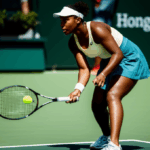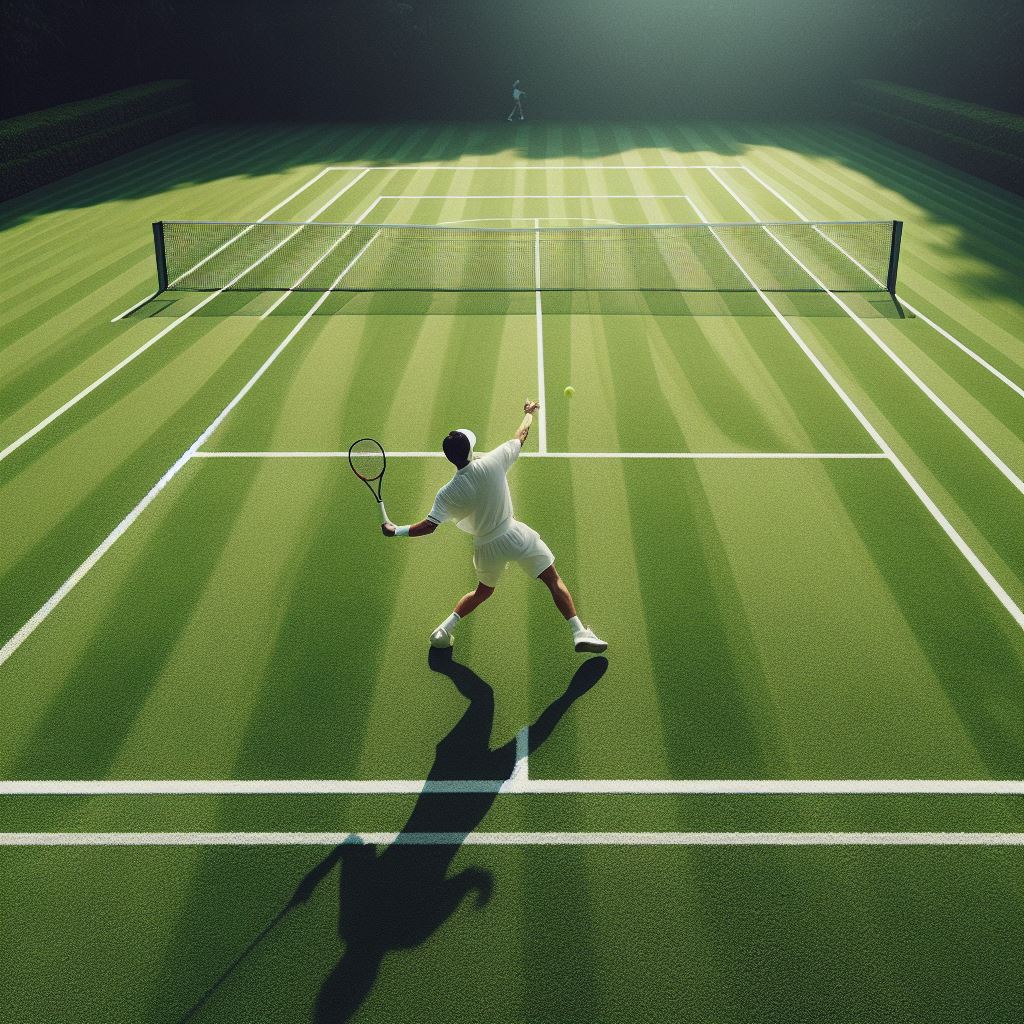In the realm of classic tennis, the grass court presents a unique challenge that demands precision, adaptability, and strategic finesse. To navigate this distinct playing surface with mastery, players must possess a keen understanding of footwork, balance, and the art of serve and volley.
Additionally, the skillful use of slice shots and strategic game plans can prove instrumental in securing victory on the grass. In this article, we delve into the essential grass court tips that will empower players to elevate their game to new heights.
Key Takeaways
- Agility is crucial for navigating the quick and unpredictable nature of a grass court.
- Stay low to effectively anticipate and react to low bounces.
- Master the art of serve and volley to put pressure on opponents and dictate the pace of the game.
- Utilize slice shots to your advantage by offering more control, introducing variation, and setting up opportunities at the net.
Footwork and Balance
When playing classic tennis on a grass court, achieving proper footwork and balance is essential for maximizing performance and minimizing the risk of injury. Grass courts are known for their slippery surface, making it crucial for players to improve their agility and maintain a proper stance.
Improving agility is vital on a grass court due to the quick and unpredictable nature of the surface. Players need to be able to move swiftly in all directions, anticipating the ball’s trajectory and adjusting their position accordingly. This can be achieved through regular practice drills that focus on quick changes of direction, lateral movements, and explosive starts.
Maintaining a proper stance is equally important when playing on grass. The slippery surface requires players to have a lower center of gravity and a wider base of support to maintain balance. This ensures stability and allows for quick changes in direction without losing control. It is crucial to bend the knees slightly, keep the weight evenly distributed between both feet, and maintain a relaxed but firm grip on the ground.
Adjusting to the Low Bounces
Achieving success on a grass court requires players to adapt to the challenging task of adjusting to the consistently low bounces, which can significantly impact shot selection and execution. As the ball skids and stays low, it becomes crucial for players to modify their technique and approach. Here are some techniques for handling unpredictable bounces and adapting your game for faster grass court conditions:
- Stay low: On grass, it is essential to maintain a lower center of gravity to anticipate and react to the low bounces effectively. Bend your knees slightly and stay light on your feet to adjust quickly.
- Footwork: Quick and precise footwork is vital when playing on a grass court. Focus on taking smaller steps and being ready to move in any direction to reach the ball comfortably.
- Slice shots: Utilize slice shots more frequently as they can stay low and skid through the surface, making it challenging for your opponent to handle. The slice will also help you keep the ball low and control the pace of the game.
Mastering the Art of Serve and Volley
To excel on grass courts, players must develop mastery in the art of serve and volley, a technique that maximizes control and unpredictability, building upon their adaptability to low bounces. Serve and volley is a strategy where the player serves aggressively and immediately rushes towards the net to hit a volley before their opponent can react effectively. This style of play puts pressure on the opponent and allows the server to dictate the pace of the game.
To master the art of serve and volley, players need to focus on two key aspects: net play techniques and improving serve accuracy. Net play techniques involve positioning, footwork, and reflexes at the net. The player must be able to move quickly and efficiently, anticipating their opponent’s shots and reacting with precision. Additionally, having a strong volley technique is crucial for successful net play. Players should practice hitting volleys with proper technique, emphasizing control and placement.
Improving serve accuracy is also vital for a successful serve and volley game. Serving accurately will put the opponent under pressure right from the start, making it more difficult for them to return the ball effectively. Players should focus on developing a consistent toss, a smooth swing, and good ball placement. Practicing different types of serves, such as the slice or the kick serve, can also add variety and unpredictability to their game.
By mastering the art of serve and volley, players can exploit the grass court’s unique characteristics and gain an advantage over their opponents. It requires practice, precision, and adaptability, but the rewards are well worth it.
| Net Play Techniques | Improving Serve Accuracy |
|---|---|
| Positioning at the net | Developing a consistent toss |
| Footwork and reflexes | Smooth swing technique |
| Anticipating opponent’s shots | Good ball placement |
| Strong volley technique | Practicing different types of serves |
Utilizing Slice Shots to Your Advantage
To enhance their grass court game, players can leverage the strategic advantage of utilizing slice shots. This technique involves hitting the ball with a downward and sideways motion, causing it to skid and stay low off the grass surface. Here are three key reasons why incorporating slice shots can be beneficial:
- Control: Slice shots allow players to have more control over the ball, as it has less spin and bounces lower. This makes it harder for opponents to return the ball with power and accuracy.
- Variation: By adding slice shots to their repertoire, players can introduce variation in their game. This keeps their opponents guessing and makes it more difficult for them to anticipate the trajectory of the ball.
- Approaching the net effectively: Slice shots can be used as approach shots to set up opportunities to come to the net. The low bounce of the ball makes it challenging for opponents to execute passing shots, giving the player at the net an advantage.
Incorporating slice shot techniques and mastering their execution can greatly enhance a player’s grass court game. By utilizing these shots strategically, players can control the pace of the game, keep their opponents off balance, and create opportunities to approach the net effectively.
Now, let’s explore strategies for playing on grass courts.
Strategies for Playing on Grass Courts
One key strategy for playing on grass courts is to capitalize on the surface’s unique characteristics. Grass courts are known for being fast-paced and low-bouncing, which requires players to adjust their tactics and adapt their game accordingly.
One important tactic for approaching net play on grass courts is to take advantage of the quick surface by coming to the net more frequently. The fast nature of grass court matches allows players to get to the net faster and put pressure on their opponents. By approaching the net, players can force their opponents to hit low and difficult passing shots, increasing the chances of winning the point.
In order to adapt to the fast-paced nature of grass court matches, players should focus on having quick footwork and anticipation. The low-bouncing nature of the surface means that players have less time to react to shots, so being able to move efficiently and read their opponent’s shots becomes crucial. Additionally, players should aim to hit flatter shots with less topspin, as this can help the ball skid through the grass and stay low, making it harder for opponents to return.
Frequently Asked Questions
What Are the Best Shoes to Wear for Playing on Grass Courts?
To maintain balance on grass courts, it is crucial to wear the best shoes that provide excellent traction. Look for shoes with rubber or studded soles, as they offer better grip and stability on the slippery surface.
How Can I Improve My Agility and Footwork on Grass Courts?
Improving agility and footwork on grass courts can be achieved through various techniques. Enhancing balance and reaction time are key factors in achieving success. Implementing specific drills and exercises tailored for grass court play can significantly improve these skills.
Are There Any Specific Techniques to Adjust to the Low Bounces on Grass Courts?
Adjusting to the low bounces on grass courts requires specific techniques. By mastering footwork and approach shots, players can enhance their ability to anticipate and adjust to the unpredictable nature of the surface, ultimately improving their performance on grass.
What Are Some Common Mistakes to Avoid When Serving and Volleying on Grass?
When serving and volleying on grass courts, it is important to adapt to the faster pace and low bounces. Common mistakes to avoid include being too aggressive, not adjusting footwork, and failing to anticipate the ball’s trajectory.
How Can I Effectively Use Slice Shots as a Strategy on Grass Courts?
Using slice shots on grass courts can be an effective strategy due to the low bounce and fast pace of the surface. However, it also carries risks, such as the ball skidding and opponents counteracting with slice shots of their own.
Conclusion
In conclusion, mastering the art of playing on grass courts requires a combination of footwork, balance, and adaptability to the low bounces. It also involves utilizing the serve and volley technique effectively and taking advantage of slice shots.
By implementing these strategies, players can enhance their performance on grass courts and increase their chances of success in classic tennis. Just like the grass itself, the game requires precision, agility, and the ability to adapt to changing conditions.








No Comment! Be the first one.